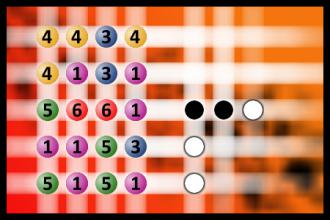What a winning combination?
The computer chose a secret code (sequence of 4 digits from 1 to 6). Your goal is to find that code. Black circles indicate the number of hits on the right spot. White circles indicate the number of hits on the wrong spot.Correct answers: 76
The first user who solved this task is Sanja Šabović.
#brainteasers #mastermind

Nude Tiptoer
A woman who plays cards one night a month with a group of friends was concerned that she always woke up her husband when she came home around 11:30.
So she decided to be considerate and not rouse him this time. She undressed in the living room and, purse over arm, tiptoed nude into the bedroom, only to find him sitting up in bed, reading.
"Oh No!" he exclaimed. "Did you lose EVERYTHING?!?"

